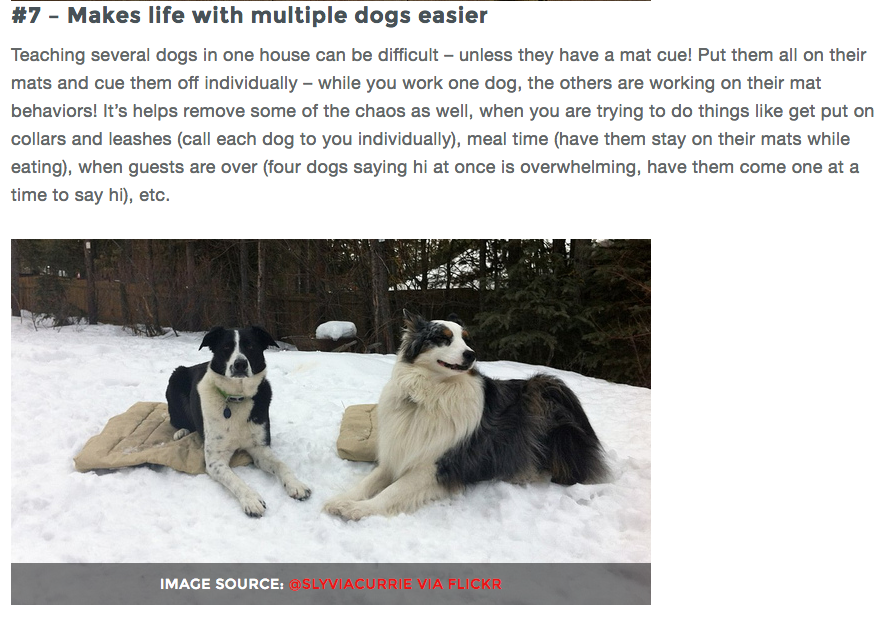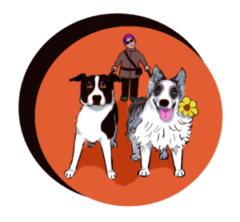Have you come across this before? — canine professionals who express outrage that their work has been used elsewhere without permission or attribution?
In some cases I can understand, and relate. There’s nothing worse than putting a lot of effort into something and then not getting the credit you deserve. However, I’ve noticed this reaction is often not about the importance or quality of the work at all. It could be about a blurry snapshot posted to Facebook of a dog digging a hole. The “photographer” is still mad as hell it got shared.
What if you made it easier for others to “steal” your work? It may sound counterintuitive, but allowing people to use your work without having to go through the process of asking for permission can result in you receiving the recognition you want.
The case of the terrible photos
I’ve come across my images used in articles around the web. For example, this [terrible] photo of Maxwell in a Thundershirt was used on a PETA website: www dot petalatino dot com/en/blog/help-dogs-on-fourth-july*

Also, this image of Maxwell and Maggie was used in an article on iHeartDogs: 7 Reasons Why Your Dog Should Learn How To “Go To Bed” On Command.

Why are my terrible photos being used?
I make it easy for people to use my work, even crummy photos, by using a Creative Commons (CC) copyright license.
CC licenses let you easily change your copyright terms from the default of “all rights reserved” to “some rights reserved’.
Informed authors searching for appropriate media to use in a blog post or curriculum materials are likely going to try CC licensed materials first. This is becoming easier to do using tools like Creative Commons Search. Some web services have built in tools, like Flickr.
The advantage of using CC licenses is that you can be clear about the terms under which your work can be used. So rather than defaulting to ‘all rights reserved’, which others don’t necessarily understand or respect, you are giving permission up front to use the work in a way that suits you.
Here’s a list of the licensing options, conveniently copied directly from the Creative Commons website because the content on that site uses a CC-BY license. (See how easy it is?)
All CC licenses require that others who use your work in any way must give you credit the way you request, but not in a way that suggests you endorse them or their use.
You let others copy, distribute, display, perform, and modify your work, as long as they distribute any modified work on the same terms.
You let others copy, distribute, display, perform, and (unless you have chosen NoDerivatives) modify and use your work for any purpose other than commercially.
You let others copy, distribute, display and perform only original copies of your work.
"License Conditions” by Creative Commons is licensed under CC BY 4.0 / removed final sentence in each section
Note that with CC licenses, attribution is always a requirement, regardless of the combination of options you choose.
Which license to use?
The content of sylviacurrie.ca is licensed as follows:
This work by Sylvia Currie is licensed under a Creative Commons Attribution-NonCommercial 4.0 International License.
I chose the noncommercial clause because I prefer that any articles, dog training handouts, etc., not be packaged up and sold. Right now I’m not sure anyone would want to, but as the body of work expands, that is a possibility.
Likewise, Julia Morton and I make the content on Rover and Chubby, (stories, illustrations, etc) available at no cost, and also license it noncommercial. Further, we include a ShareAlike requirement in the CC license. This means that others must use the same terms for any publications that include our work. It’s not too much to ask, really. It makes sense that we preserve this cost-free access when the content is in the hands of dog trainers, publishers. and the like.

As for the images of my dogs? In hindsight, I probably should have make those photos Public Domain, meaning free of any copyright restrictions. I mean, they’re terrible photos! However, I still like that attribution is given, and with the ability to track links to your website it’s fun to see your terrible photos pop up elsewhere. 🙂
Why make your work freely available for others to share and repurpose?
My dog photo examples are creations I don’t really care about, so in those cases there’s really no reason not to use CC license. But I also assign a CC license to articles, stories, poems, lesson plans, guides, presentation slides, etc.
Here’s my rationale:
- A CC license isn’t instead of copyright; you still own the copyright, and it doesn’t prevent you from doing whatever you want with your own work.
- Your work is more likely to be noticed. An article that is copied and passed around is obviously reaching a larger audience. If you aim to raise awareness about your beliefs, philosophies, ideas, services, business name, or whatever, then a CC license will help you. Frankly, I think this is the most important strategy the force free dog training community can take.
- Others can benefit from what you share and you can benefit from what others share. If you need a handout on force free vet visits to give to your clients, how much sense does it make to start from scratch? If there’s a CC-licensed version, use that! Then spend all that precious extra time playing with your dog.
- There’s a possibility that the work will be improved by someone else, which you in turn can use (if you use the right license). How great is that!
- Openly sharing your work doesn’t make it less sought after. In fact, being very protective of your creative and intellectual property can turn people away. Ever click through a series annoying marketing teasers only to find you need a paid subscription? Consider making a selection of resources available even if your plan is to charge a fee for content packages. Or rethink your business model altogether; focus on your services instead.
- Remember that content does not a teacher make. Your value to your clients is in your planning, coaching, teaching, consulting… you get the idea.
Be proactive
As I look around the web I see very few dog training professionals using Creative Commons licenses. So rather than complain that people are using your work without attribution, why not use a copyright license that makes it clear how they can use the work, and ensures you get the credit you deserve?
* I do not support PETA in any way and therefore don’t link to their websites
